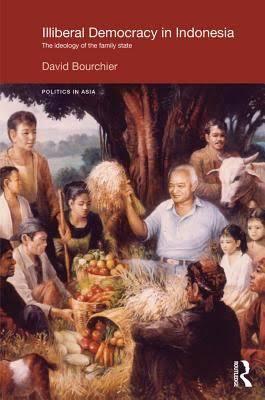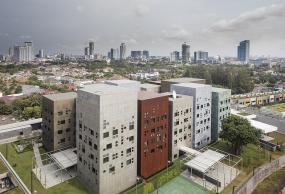
“You have to know the past to understand the present.” Astronomer Carl Sagan
Official public monuments are the victors’ version of history. The most conspicuous example in Indonesia is Pancasila Sakti [Sacred Pancasila], where the inscribed founding principles of 1945 are overshadowed by giant statues of seven officers slaughtered in an alleged communist coup 20 years later.
General Soeharto, who later became the Republic’s second president, linked the separate happenings to give his authoritarian Orde Baru (New Order) administration legitimacy. He composed the oxymoron “guided democracy”.
Although many “facts” about the event have been debunked by US scholars, families still go to Pancasila Sakti in East Jakarta to gawp at sickening dioramas of the killings to shape their understanding of history.
Indonesia identity has many wellsprings. The original has the theme of perjuangan [struggle] culminating in first president Soekarno’s proclamation of independence on August 17, 1945.
Unlike their neighbors on the Malay Peninsula, Indonesians didn’t wait for a benign European overseer to bestow freedom. They seized it and hung on through a grim four-year guerrilla campaign to drive the Dutch from their prized colony.
This story has become more accessible to Westerners this year with Australian journalist Dr Frank Palmos’ translation of Student Soldiers (published by Obor), the memoirs of street fighter Suhario Padmodiwiryo.
There are few kampongs in Indonesia without a concrete spearman or machine gunner guarding the entrance below the slogan Merdeka! [Freedom]. Repainted every August, they remind the smartphoners: this is how the oldies built the land you now enjoy.
Earlier history offers more nuanced explanations of influences that have formed the world’s largest Muslim populated nation with a reputation for practising moderate Islam.
Long before the 16th century Europeans arrived in the Spice Islands, Chinese and Indian traders brought their different faiths and worldviews. These helped create the mighty 15th century Majapahit Kingdom, still seen by utopians as the Golden Age.
Their crumbling temples, sacred sites, masks, dances, music and ancient beliefs litter the landscape of Java as adat, the customs and traditions that maintain Indonesian values.
Some believe such symbols and tenets are indigenous, mystical, ready to reappear and unique to the archipelago. The critical question: could the well-embedded folklore, coupled to Soeharto’s corrupted version of the past, threaten Indonesia’s teenage democracy, born 1998, still fumbling with change and frustrating its citizens?
Australian academic Dr David Bourchier thinks there’s a chance. He’s been identifying the remnants of collapsed ideologies and deciding which remain viable, like archaeologists rebuild shrines from shattered stones and vandalised statuary.
He’s spent the last two decades assembling the pieces for Illiberal Democracy in Indonesia: The Ideology of the Family State published by Routledge.
The cover features a cynical tableau by Solo artist Herri Soedjarwanto in the 19th century British cornucopia style. It shows a jolly Soeharto at the head of a food-laden table, surrounded by admirers.
The author calls it “an intellectual detective story”. It’s certainly that, and better than the sanitized accounts of the nation’s gestation and birth pangs served to schoolkids since the 1965 coup.
The lust for freedom from Dutch colonialism peaked in the 1940s. The Indonesia we know today almost didn’t happen as blue-sky notions collided with international events. Fundamentalists came close to forcing a theocracy. The occupying Japanese could have run amuck as their empire collapsed.
Had the Marxists triumphed the People’s Republic of Insulindia would now be worrying the West. If sentimentalism had prevailed Indonesians would now be speaking Javanese and have a Thai-style dysfunctional government.
The bright youngsters who imagined a new world and are now lauded as nation-building heroes, would today be condemned as traitors. In West Papua [taken over by Soeharto in 1969] they’d be imprisoned for seeking independence.
One of the few women among the founder-thinkers was lawyer Maria Ulfah Santoso, who protested the absence of basic rights in the draft Constitution. Her concerns were flicked aside by the macho men.
Like her fellow activists during the 1920s Santoso had been educated in the Netherlands. They dined on an eclectic menu - Marxism, Fabian socialism, notions of the nation state, church interpretations of a secular society, free thinkers, European anti-colonialism; if there was an ‘ism’, it was there.
At the same time, though far away, the feudal Japanese were getting interested in the Dutch East Indies with an empire in mind. They’d already shown muscle; in 1905 they thrashed the Russian Navy at the Battle of Tsushima during the Russo-Japanese War.
Writes Bourchier: “Accounts by early Indonesian nationalists highlight this first victory by an Asian nation over a European power … as a tremendous inspiration…The Japanese changed the way Indonesians thought about themselves.”
So, hardly surprising Indonesians welcomed the 1942 invasion and for a while cooperated till discovering the new rulers’ real interests were resources for war. The brutality of the romusha forced labor system scarred families everywhere. The invaders might be fellow Asians but not allies; Indonesians would have to fight alone for freedom.
First Vice President Mohammad Hatta found the Japanese imperialism unpalatable. Although feted as the “Gandhi of Java” during a visit, he was unmoved by flattery. Indonesians should give thanks; a lesser man might have imported the North Asian military ideology.
Ki Hajar Dewantara, a Javanese journalist and activist whose writings combined elements of Javanese, Indian and Theosophical thinking, was another spreading ideas of “Eastern Democracy” and “feeling-of-family.”
Singapore’s Lee Kuan Yew with his “Asian values” popularized the same idea.
Cosy notions, easy to understand and exploit – one nation, one kin group. The citizen children would be properly guided by wise and just rulers [Ratu Adil] demanding obedience. No need for checks and balances.
By contrast with the refined and respectful Javanese approach to authority, the Western model of democracy puts power in the people’s hands; everyone an equal individual entitled to her or his opinion, sceptical of authority and demanding limits to state power .
The “Decent Daddy” principle is now legless. But before Soeharto was revealed as a kleptomaniac, allegedly accumulating $9 billion, his definition of the State ruled for 32 years: a big happy family with bloodlines and beliefs stretching back into the misty rural hinterland where all was pure and perfect.
Some hanker for those good old fantasy days. T-shirts of Soeharto captioned “better in my time, ya?” are on sale. While liberals see Indonesia’s democracy as a beacon to Asia and the Islamic world, others claim it’s a quarrelsome Western implant upsetting indigenous values of harmony.
Could Indonesians, fed up with corruption, inactivity and political bickering retreat to “a more culturally authentic style of rule?” Translation: authoritarianism.
Bourchier warns that for Indonesia to avoid repeating history “there needs to be a concerted effort to construct a national identity more in tune with the needs of a pluralistic, dynamic, democratic nation.
“A necessary first step is to look critically at romantic notions of the Volksgeist [spirit of the people] in both legal and political thinking.
“It is only with an understanding of how key concepts such as musyawarah [consensus after long discussion] gotong-royong [community self-help] kekeluargaan [shared kinship] and adat came to be part of Indonesian public discourse and how they have been deployed for anti-democratic ends that they will begin to lose their seductive power.”
Perjuangan – the struggle continues.
The author is an Australian journalist living in East Java. www.indonesianow.blogspot.com










%20resized.png)
